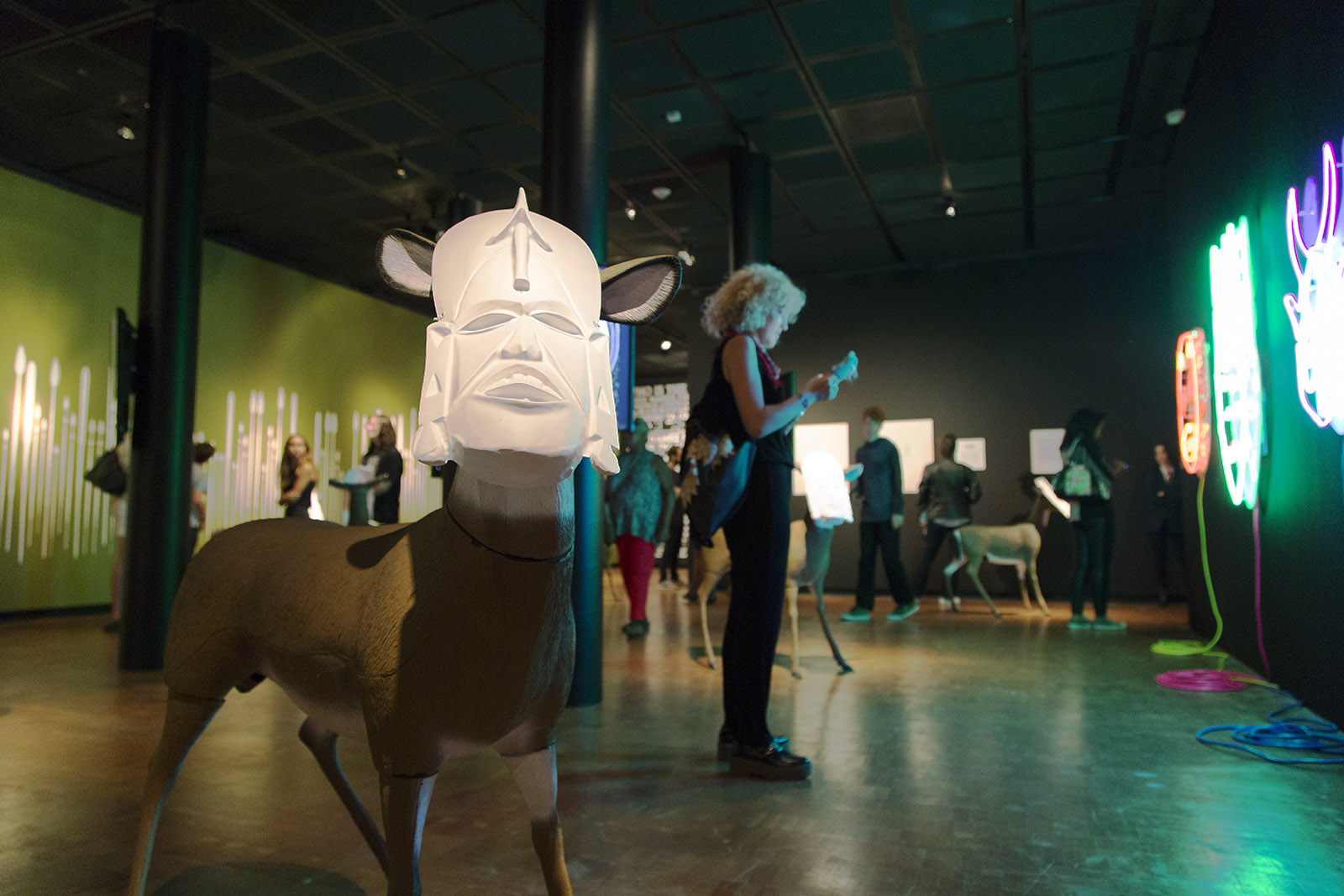Twelve artists showcase African culture-inspired art at Fowler Museum

Brendan Fernandes created this sculpture of a plastic deer wearing a plastic mask to examine the lack of authenticity in the portrayal of African culture. (Owen Emerson/Daily Bruin senior staff)
A masked figure cloaked head to toe in white stepped onto the streets of Lagos, Nigeria. People chatting with fellow shoppers and haggling for merchandise looked up at the figure and moved aside in reverence, understanding the significance of the costume belonging to the exclusively male ancestor ritual of egungun.
The person wearing the egungun mask, however, was a woman. In the disguise of the egungun mask, she felt power and freedom of movement in a space normally reserved exclusively for men.
“The space of masquerade is really powerful,” said Wura-Natasha Ogunji, the artist who designed the egungun costume for the female performer on the streets of Lagos. “It allows for things to happen that aren’t allowed in formal society.”

Ogunji is one of twelve artists whose artwork is showcased in the Fowler Museum exhibition “Disguise: Masks & Global African Art.” Ogunji said the collection, which opened Sunday and will be displayed through March, is influenced by themes such as gender and authenticity in African culture and society.
One of Ogunji’s goals was to make the connection between how spectators normally see African artwork – on the walls of a museum – and seeing the costumes in action.
To add context to the costume, Ogunji filmed the performer walking through the streets of Lagos.
She then projected the video onto the wall behind the pieces, which she said breathed life and cultural significance into an inanimate costume.
“Many of these objects don’t sit in museums where they originate,” Ogunji said. “They have a place, they have a purpose.”
Brendan Fernandes, an artist participating in the exhibition, was inspired to study authentic representation of African culture by a scene he came across in Canal Street, New York.
As he walked down the street, he noticed West African vendors selling plastic tribal masks resembling Maasai men with stretched earlobes and painted faces.
The sight of the plastic mask struck him hard: Fernandes, whose family has lived in Kenya for five generations, said the Maasai culture does not use masks.
Fernandes said the ubiquity of the plastic tribal masks in street vendor trade make the false image of Maasai culture representative of continental African culture.
“The mask is a totally produced object, but it’s become known as a stand-in for Africa,” Fernandes said.
In response to the lack of authenticity he saw on Canal Street, Fernandes made his own masks out of plastic and placed them on plastic deer models, which are normally used as hunting decoys. He set the structures in front of what he called a “safari green” backdrop.
To Fernandes, the deer represented hiding from the reality of African culture behind the veneer of a white, plastic mask that many people associate with Africa.
The idea, Fernandes said, was to expose the insincerity in the portrayal of African art.
Sophia Cesaro, the events and visitor services manager at the Fowler Museum, said bringing the art collection to UCLA can help foster appreciation for a culture some students have no exposure to.
“These artists are giving powerful interpretations of their experiences and culture,” Cesaro said. “Even though the artists are from different places, they’re all uniting with their art.”

Ogunji said the ultimate goal of the exhibition is to create a tangible presence for African rituals, ceremonies and the people involved in practicing them.
Underneath the superficial meaning of a mask as a disguise, Fernandes said masks follow the culture and heritages of living people and are products of their ever-changing environment.
“Africa is a continent that is diverse and has many histories,” Fernandes said. “We want you to be able to hear our voices in our art.”


